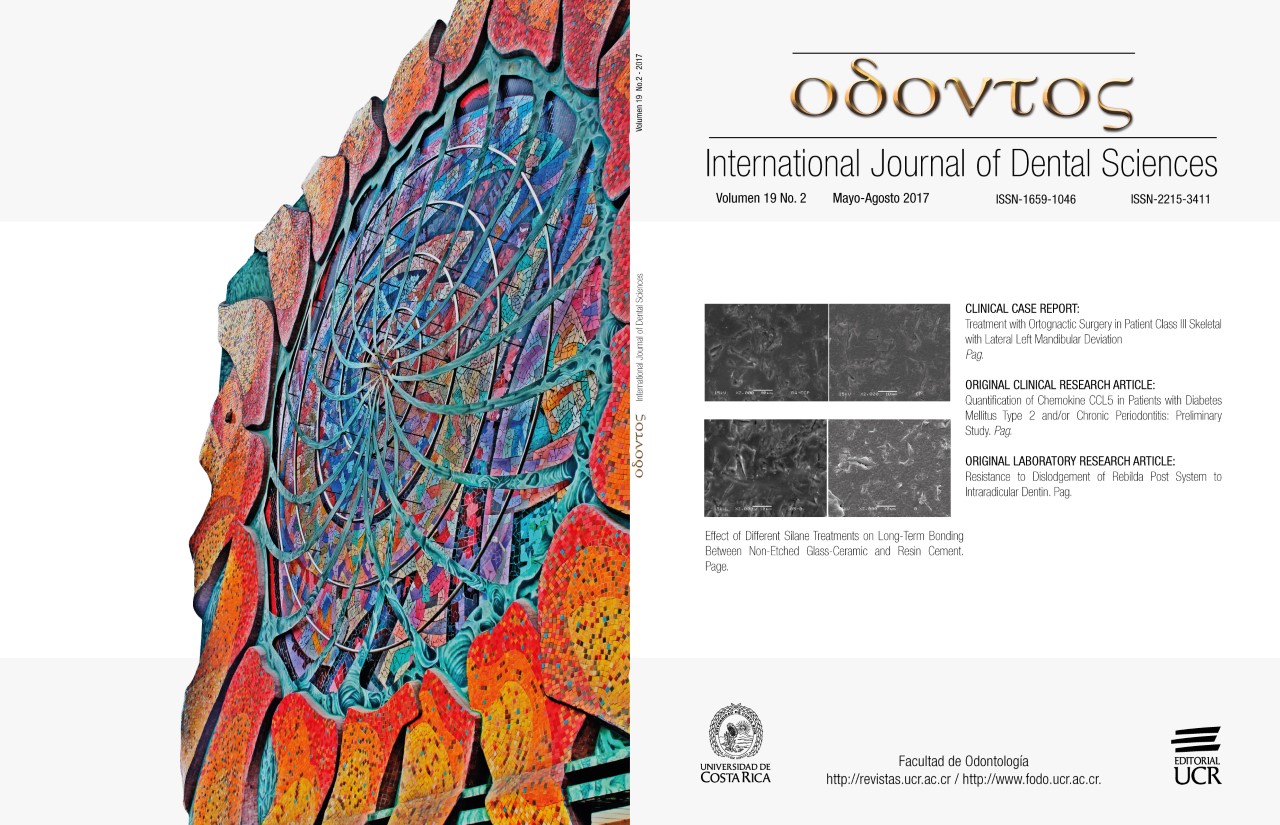Abstract
The purpose of the present study was to quantify the presence of chemokine CCL5 (RANTES) in gingival crevicular fluid (LCG) in patients with chronic periodontitis (PC) and / or type 2 diabetes mellitus (DM2). A comparative cross-sectional study was conducted in 40 patients. LCG was taken from periodontal pockets and gingival grooves from 4 patient groups (10 per study group); patients who received periodontal, antibiotic and anti-inflammatory treatment 6 months prior to the study or who had systemic disease other than DM2 were excluded. Concentrations of CCL5 were determined by LUMINEX® assays. Descriptive statistics, one-way ANOVA, Student's T, and Pearson's correlation were performed. The quantification of CCL5 was higher in the patients who presented both diseases, followed by the group with only PC, healthy and the group with only DM2. No significant difference was found between groups and there was no correlation between quantifications and glycemic indicators. Although the differences were not significant, the group of patients with both diseases had the highest CCL5 quantification. The expression of CCL5 in LGC should be considered as a potential inducer of periodontal destruction, its determination could be useful for monitoring the health/disease of periodontal tissues.
References
Perioodontología clínica. 10ª ed. México: McGraw-Hill Interamericana; 2007.
Lindhe J. Periodontología clínica e implantología oral. 4ª ed. Buenos aires: Panamericana; 2005.
Guerrero-Velázquez C. Perfiles de citocinas en periodontitis. Odontología Actual. 2009; 6 (61): 12-20.
Peña-Sisto M., Calzado-DaSilva M., Gonzalez-Peña M., Cordero-Garcia S., Azahares-Arguello H. Patogenos Periodontales y sus relaciones con enfermedades sistemicas. MEDISAN. 2012; 16 (7): 1137-48.
Liébana J., Castillo A., Álvarez M. Enfermedades periodontales: consideraciones microbiológicas. Med Oral Patol Oral Cir Bucal. 2009; 9 (suppl): 75-91.
Dana T., Liu R., Oates T. Inflamación y apoptosis potenciadas por la diabetes: impacto sobre la salud periodontal. Periodontol 2000. 2008; 20 (2): 80-6.
Shlossman M., Knowler W. C., Pettitt D. J., Genco R. J. Type 2 diabetes mellitus and periodontal disease. J Am Dent Assoc. 2008; 121 (4): 532-6.
Jansson H., Lindholm E. Type 2 diabetes and risk for periodontal disease: a rol for dental health awareness. J Int Acad Periodontol. 2009; 8 (4): 20-4.
Taylor G. W., Burt B. A., Becker M. P., Genco R. J., Shlossman M., Knowler W. C., Pettitt D. J. Non-insulin dependent diabetes mellitus and alveolar bone loss progression over 2 years. J Periodontol. 2007; 69 (1): 76-83.
Pickup J. C., Crook M. A. Is type 2 diabetes mellitus a disease of the innate immune system. Diabetologia. 2007; 41(10): 1241-8.
Nishimura F., Soga Y., Iwamoto Y., Kudo C., Murayama Y. Periodontal disease as part of the insulin resistance syndrome in diabetic patients. J Int Acad Periodontol. 2009; 7 (1): 16-20.
Ferreira S., Repeke C., Ávila M. CCR5 mediates pro-osteoclastic and osteoclastogenic leukocyte chemoattraction. J Dent Res. 2011; 90 (5): 632-7.
Emingil G., Atilla G., Huseyinov A. Gingival crevicular fluid monocyte chemoattractant protein-1 and RANTES levels in patients with generalized aggressive periodontitis. J Clin Periodontol. 2008; 31 (10): 829-34.
Gamonal J., Acevedo A., Bascones A., Jorge O., Silva A. Levels of interleukin 1 beta, -8, and -10 and RANTES in gingival crevicular fluid and cell populations in adult periodontitis patients and the effect of periodontal treatment. J Periodontol. 2007; 71 (10): 1535-45.
Levy J. The unexpected pleiotropic activities of RANTES. J Immunol. 2009; 182 (7): 345-6.
Standard of medical care in diabetes. Diabetes Care. 2010; 33 (suppl 1) s11 61.
Kinane D. Causas y patogenia de la enfermedad periodontal. Periodontol 2000 (Ed Esp) 2009; 1 (25): 8-20.
Gamonal J., Bascones A., Jorge O., Silva A.. Chemokine RANTES in gingival crevicular fluid of Adult patients with periodontitis. J Clin Periodontol. 2000; 27 (9): 675-81.
Savario L., Donati M., Carr C. Interleukin-24, RANTES and CCR5 gene polymorphisms are not associate with chronic adult periodontitis. J Periodontol Res. 2006; 42 (2): 152-8.
Gamonal J., Acevedo A., Bascones A., Jorge O., Silva A. Characterization of cellular infiltrate, detection of chemokine receptor CCR5 and interleukin-8 and RANTES chemokines in adult periodontitis. J Periodontal Res. 2001; 36 (3): 194-203.
Emingil G., Atilla G., Huseyinov A. Gingival crevicular fluid monocyte chemoattractant protein-1 and RANTES levels in patients with generalized aggressive periodontitis. J Clin Periodontol. 2008; 31 (10): 829-34.
Thunell D., Tymkiw K., Johnsom G., Joly S. A multiplex immunoassay demonstrates reductions in gingival crevicular fluid cytokines following initial periodontal therapy. J Periodontol Res. 2010; 45 (1): 148-52.
Kabashima H., Yoneda M., Nagata K. The presence of chemokine (MCP-1, MIP-1 alpha, MIP-1beta, IP10, RANTES)-positive cells and chemokine receptor (CCR5, CXCR3)-positive cells in inflamed human gingival tissues. Cytokine. 2002; 20 (2): 70-7.
Herder C., Thomas I., Jens B., Muller M., Klop N. RANTES/CCL5 polymorphisms, serum concentrations, and incident type 2 diabetes: results from the MONICA/KORA Augsburg case-cohort study, 1984-2002. Eur J Endocrinol. 2008; 158 (5): 253-60.
Bulut U., Develioglu H., Taner I. Interleukin-1 beta levels in gingival crevicular fluid in type 2 diabetes mellitus and adult periodontitis. J Oral Sci. 2001; 43 (3): 171-7.
Cutler C., Machen R., Jotwani R. Heightened gingival inflammation and attachment loss in type 2 diabetics with hiperlipidemia. J Periodontol. 1999;70 (11): 1313-21.
Kardesler L., Buduneli N., Biyikoglu B. Gingival crevicular fluid PGE2, IL-1 beta, t-PA, PAI-2levels in type 2 diabetes and relationship with periodontal disease. Clin Biochem. 2008; 41 (10-11): 863-8.
Navarro-Sanchez A., Faria-Almeida R., Bascones-Martinez A. Effect of non-surgical periodontal therapy on clinical and immunological response and glycaemic control in type 2 diabetic patients with moderate periodontitis. J Clin Periodontol. 2007; 34 (10): 835-43.
Vieira-Ribeiro F., de Mendoca A., Santos V., Bastos M. Cytokines and bone-related factors in systemically healthy patients with chronic periodontitis. J Periodontol. 2011; 82 (8): 1187-96.
Atieh M., Faggion C., Seymour G. Cytokines in patients with type 2 diabetes and chronic periodontitis: A systematic review and meta- analysis. Diabetes Res Clin Pract. 2014; 104 (2): 38-45.
Duarte P., Bezerra J., Miranda T., Chambrone L. Local levels of inflammatory mediators in uncontrolled type 2 diabetic subjects with chronic periodontitis. J Clin Periodontol. 2014; 41 (1): 11-8.

